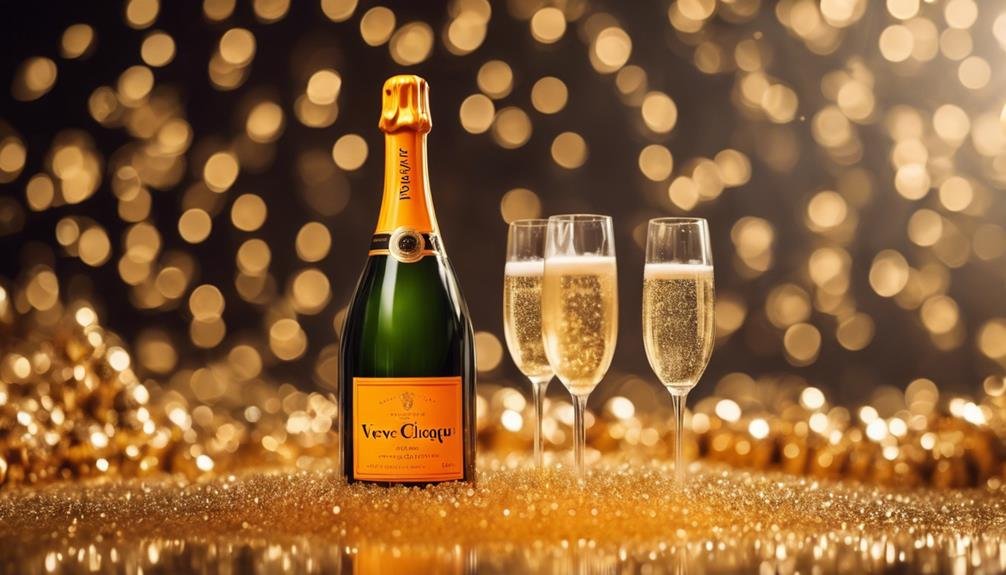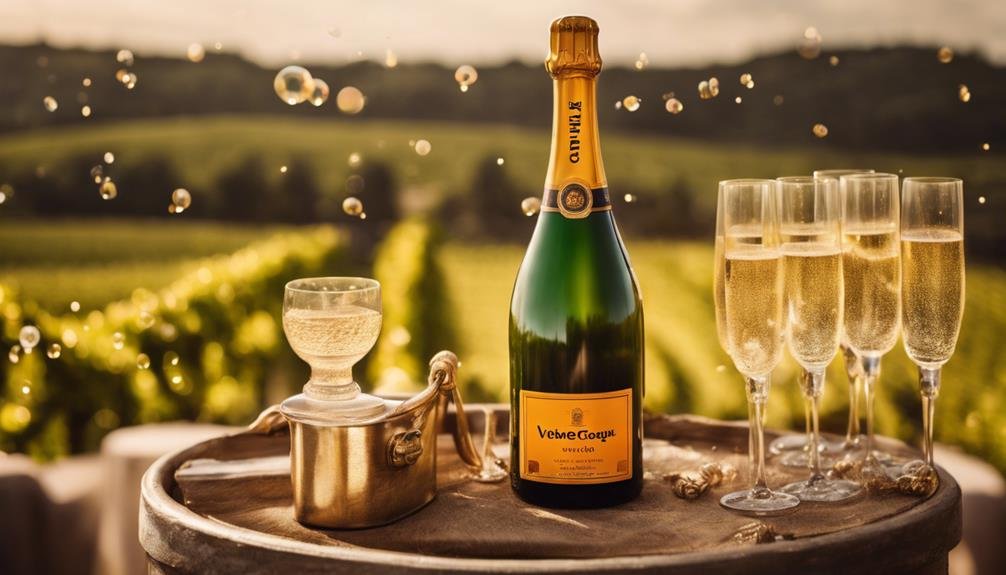Barbe-Nicole Ponsardin, born in 1777, inherited Veuve Clicquot at 27, transforming the champagne industry. She pioneered vintage bottling, the Remuage technique, and marketed rosé champagne. Her yellow label symbolizes luxury. The industry blends tradition with innovation, focusing on sustainability, and embracing technology. Veuve Clicquot, under her, expanded globally, setting industry standards. Her legacy, breaking gender barriers, inspires female entrepreneurs. Champagne, synonymous with celebration, continues evolving to cater to modern tastes. Explore how her trailblazing vision impacts today's luxury spirits and wine world.
Early Life and Entrepreneurship
Barbe-Nicole Ponsardin's journey towards becoming the pioneering businesswoman known as the 'Grande Dame of Champagne' began in Reims, France, where she was born on December 16, 1777, to the affluent textile tycoon Ponce Jean Nicolas Philippe.
Despite societal norms of the time, Barbe-Nicole exhibited an early entrepreneurial spirit, which she honed through her father's business ventures. However, personal challenges arose as she faced the untimely death of her husband, François Clicquot, leaving her widowed at only 27 years old.
This pivotal moment propelled her into the world of business, where she not only took over the reins of the Veuve Clicquot business but also reshaped the champagne industry with her innovative approaches and unwavering determination.
Innovations in Champagne Production
In the domain of champagne production, the landscape changed dramatically with the emergence of innovative techniques introduced by a visionary figure in the industry. Barbe-Nicole Ponsardin, also known as the 'Grande Dame of Champagne,' left an indelible mark with her advancements. She was the first to bottle a recorded vintage Champagne in 1810, setting a new standard for quality. Additionally, she introduced the Remuage technique, which clarified sparkling wine by removing cloudy yeast sediment, enhancing the drink's visual appeal. These methods revolutionized champagne production, paving the way for clearer and more marketable products. Barbe-Nicole's legacy also includes pioneering the use of the Remuage system and vintage bottling, which are still essential practices in the champagne industry today.
| Innovations | Description | Impact |
|---|---|---|
| Vintage Bottling | First recorded in 1810, set a new standard for quality | Enhanced prestige of Champagne production |
| Remuage Technique | Introduced to clear sparkling wine of cloudy yeast | Improved visual appeal and marketability |
Veuve Clicquots Influence and Distinction

Veuve Clicquot's impact and distinction in the champagne industry are renowned for their innovative approaches and historic contributions. The house played a pivotal role in the Champagne revolution, particularly through Veuve Clicquot's marketing strategies that reshaped the industry.
By popularizing rosé champagne and pioneering the riddling process, Veuve Clicquot set new standards for winemaking techniques. Their distinct yellow label became synonymous with quality and luxury, attracting a global following.
This champagne house's commitment to excellence and creativity continues to shape the market, maintaining its position as a prestigious brand. Veuve Clicquot's legacy is not only about producing exceptional champagne but also about revolutionizing the way champagne is marketed and enjoyed, making it a timeless symbol of sophistication and taste.
Champagne Industry Insights
The Champagne industry showcases a blend of tradition and innovation in its winemaking practices and market presence. Sparkling trends in the industry highlight a growing interest in organic and sustainable practices, with an emphasis on terroir-driven production.
Industry evolution sees a focus on technology, from precision viticulture to advanced winemaking equipment, improving quality and consistency. Champagne houses are adapting to changing consumer preferences by offering new cuvées and modern packaging.
Additionally, the industry is exploring new markets globally, targeting younger demographics and emerging economies. In this dynamic landscape, the Champagne sector continues to uphold its prestigious reputation while embracing contemporary trends to secure its future relevance and appeal.
Enduring Legacy and Global Impact

Highlighting the enduring influence and global reach of the Champagne industry underscores its ability to merge tradition with contemporary trends, ensuring sustained relevance and appeal in diverse markets.
- Gender barriers: Barbe-Nicole Ponsardin shattered gender norms as a female pioneer in the male-dominated Champagne industry.
- Market expansion: Veuve Clicquot's strategic expansion into international markets solidified its position as a global champagne powerhouse.
- Cultural significance: Champagne has transcended borders, becoming a symbol of celebration and luxury worldwide.
- Innovation: The Champagne industry continues to evolve, blending tradition with modern techniques to meet evolving consumer preferences.
- Historical impact: Barbe-Nicole's legacy paved the way for future female entrepreneurs, leaving an indelible mark on the world of champagne.
Frequently Asked Questions
How Did Barbe-Nicole Ponsardin Balance Motherhood With Running Veuve Clicquot?
Balancing motherhood and running a business, Barbe-Nicole Ponsardin, a pioneering figure in female entrepreneurship, navigated challenges with grace. Her strategic acumen in managing Veuve Clicquot while raising a child exemplifies resilience and innovation.
What Challenges Did Barbe-Nicole Face as a Female Entrepreneur in the Early 19TH Century?
In the early 19th century, female entrepreneurship faced significant challenges due to entrenched gender barriers. Despite these obstacles, Barbe-Nicole Ponsardin triumphed, showcasing exceptional business acumen and resilience, paving the way for her remarkable business success.
How Did Barbe-Nicole Ponsardin Navigate the Political Landscape Post-French Revolution?
Barbe-Nicole Ponsardin adeptly navigated the post-French Revolution political landscape through strategic alliances and innovative market approaches. Her ability to blend political strategy with business acumen enabled her to thrive amidst the revolutionary aftermath, showcasing resilience and vision.
What Inspired Barbe-Nicole to Introduce the Remuage System in Champagne Production?
Barbe-Nicole Ponsardin introduced the Remuage system in Champagne production to enhance clarity and marketability. This innovation involved gradually tilting and rotating bottles to consolidate sediment, improving the quality of sparkling wine. Remuage revolutionized Champagne production methods, setting new industry standards.
How Does Veuve Clicquot Maintain Its Signature Taste and Quality Consistency Over the Years?
Veuve Clicquot's enduring excellence lies in a symphony of meticulous quality control measures woven into its production process. Like a maestro, it harmonizes tradition with innovation to orchestrate a timeless brand identity that resonates with evolving market trends.
Conclusion
To sum up, Barbe-Nicole Ponsardin's legacy as a pioneering figure in the champagne industry is undeniable. Her innovative strategies and groundbreaking techniques have left a lasting impact on the production and marketing of champagne.
One interesting statistic is that Veuve Clicquot, under her leadership, saw a significant increase in sales, becoming one of the most successful Champagne houses in the world.
Her enduring legacy continues to shape the industry today, solidifying her reputation as a champagne icon.
